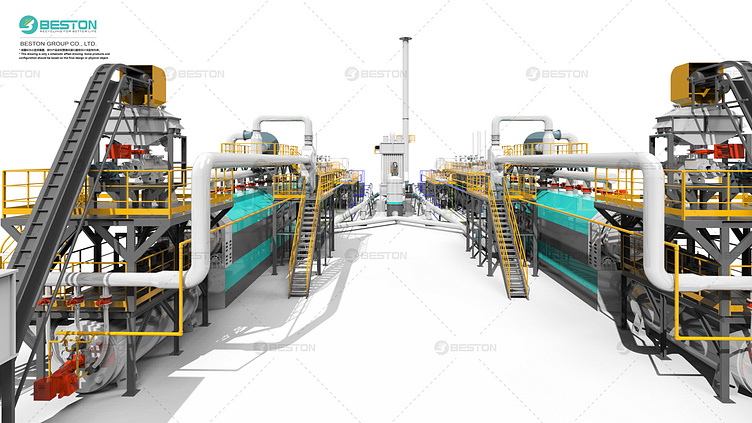Continuous Pyrolysis for Large-Scale Tire and Plastic Waste Trea
In our modern world, waste management has become a pressing global challenge, particularly with the proliferation of non-biodegradable materials like tires and plastics. Continuous pyrolysis, a cutting-edge technology, offers a sustainable solution by converting waste materials into valuable resources such as fuel, chemicals, and raw materials. In this comprehensive guide, we'll explore the principles of continuous pyrolysis machine, its application in large-scale tire and plastic waste treatment, benefits, and the transformative potential it holds for environmental conservation and resource recovery.
Understanding Continuous Pyrolysis: Continuous pyrolysis is an advanced thermal decomposition process that involves the continuous heating of organic materials, such as tires and plastics, in the absence of oxygen to break them down into gas, liquid, and solid byproducts. Unlike batch pyrolysis, which processes materials in discrete batches, continuous pyrolysis systems operate continuously, enabling uninterrupted feedstock processing and higher throughput. The process typically involves several stages, including feeding, heating, vaporization, condensation, and product collection, all performed within a controlled environment to maximize efficiency and product quality.
Principles of Continuous Pyrolysis for Tire and Plastic Waste Treatment:
Feedstock Preparation: Waste tires and plastics are shredded or granulated into smaller particles to increase surface area and facilitate uniform heating and vaporization during the pyrolysis process. This step may involve sorting and pre-treating the feedstock to remove contaminants and optimize process efficiency.
Heating and Vaporization: The prepared feedstock is continuously fed into a pyrolysis reactor, where it undergoes heating at elevated temperatures, typically ranging from 300°C to 800°C, in the absence of oxygen. As the feedstock heats up, organic compounds within the tires and plastics undergo thermal decomposition, releasing volatile gases and vapors.
Gas and Liquid Separation: The vaporized gases and liquids produced during pyrolysis are routed to a separation system, where they undergo cooling and condensation to convert them into marketable products such as syngas, pyrolysis oil, and water. This step allows for the recovery and utilization of valuable energy-rich compounds from the waste feedstock.
Solid Residue Handling: The solid residue or char remaining after pyrolysis, composed primarily of carbonaceous material and inorganic ash, is discharged from the reactor and may undergo further processing or disposal. Depending on its composition and properties, the char may be recycled for energy generation, utilized as a carbonaceous additive, or safely disposed of in accordance with environmental regulations.
Benefits of Continuous Pyrolysis for Tire and Plastic Waste Treatment:
Resource Recovery: Continuous pyrolysis enables the recovery of valuable resources from waste tires and plastics, including fuels, chemicals, and raw materials. Syngas produced during pyrolysis can be used for heat and power generation, while pyrolysis oil finds applications as a fuel or feedstock for chemical production.
Waste Reduction: By converting tires and plastics into useful products, continuous pyrolysis helps reduce the volume of waste requiring disposal in landfills or incineration facilities, mitigating environmental pollution and conserving valuable landfill space.
Energy Efficiency: Continuous pyrolysis systems are designed for high energy efficiency, with heat recovery mechanisms and process optimization techniques to minimize energy consumption and maximize resource utilization. This results in lower operating costs and reduced environmental impact compared to conventional waste treatment methods.
Environmental Sustainability: Continuous pyrolysis offers significant environmental benefits, including reduced greenhouse gas emissions, decreased reliance on fossil fuels, and prevention of soil and water contamination associated with landfilling or improper waste disposal. By closing the loop on resource utilization, pyrolysis contributes to a circular economy and sustainable development goals.
Applications of Continuous Pyrolysis:
Waste-to-Energy: Continuous pyrolysis systems can be integrated into waste-to-energy facilities to convert tire-derived fuel (TDF) and plastic waste into renewable energy sources such as electricity, heat, and biofuels. These facilities play a crucial role in addressing energy security concerns and reducing dependence on finite fossil fuels.
Chemical Manufacturing: Pyrolysis oil and syngas produced from tire and plastic waste can serve as valuable feedstocks for chemical synthesis, including the production of olefins, aromatics, and specialty chemicals. These versatile intermediates find applications in various industries, including petrochemicals, polymers, and pharmaceuticals.
Environmental Remediation: Continuous pyrolysis offers a sustainable solution for environmental remediation projects, including brownfield redevelopment, industrial site cleanup, and hazardous waste management. By treating contaminated materials onsite and recovering valuable resources, pyrolysis contributes to environmental restoration and ecosystem protection.
Future Trends and Innovations:
Advanced Process Technologies: Ongoing research and development efforts focus on enhancing the performance and efficiency of continuous pyrolysis systems through innovations in reactor design, heat transfer mechanisms, and process control technologies. These advancements aim to further optimize resource recovery and reduce environmental impact.
Circular Economy Initiatives: Increasing emphasis on circular economy principles and waste valorization strategies is driving the integration of continuous pyrolysis into broader waste management frameworks. Collaborative partnerships between industry stakeholders, government agencies, and research institutions are fostering innovation and scaling up pyrolysis technologies for sustainable resource utilization.
Technological Integration: Integration of continuous pyrolysis with complementary technologies, such as gasification, hydrothermal processing, and catalytic conversion, holds promise for expanding the range of feedstocks and enhancing product diversity. These integrated systems enable synergistic approaches to waste valorization and maximize overall process efficiency.
Conclusion: Continuous pyrolysis represents a paradigm shift in waste management, offering a sustainable, efficient, and economically viable solution for treating tire and plastic waste on a large scale. By harnessing the power of thermal decomposition to convert waste materials into valuable resources, pyrolysis contributes to environmental sustainability, resource conservation, and circular economy objectives. As technological advancements continue and market demand grows, the future of continuous pyrolysis holds immense potential for transforming waste management practices and fostering a more resilient and resource-efficient society.

